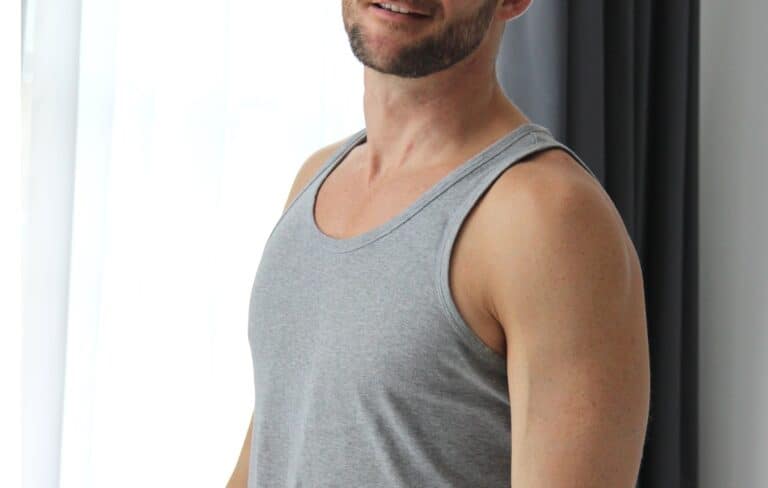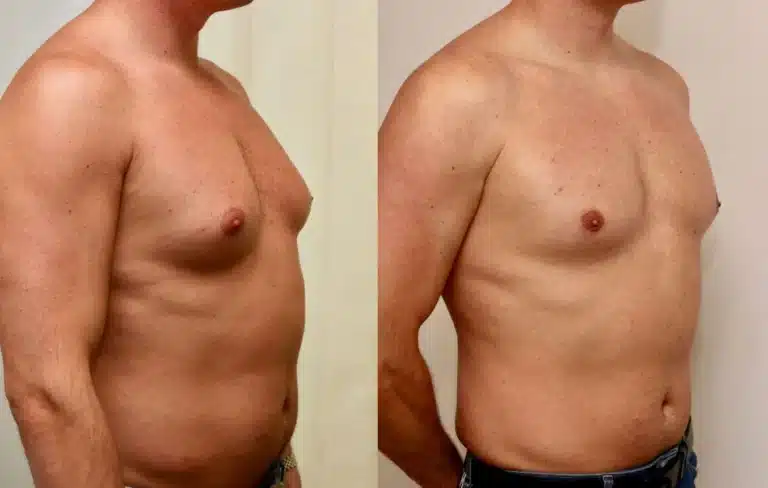
Before you leave the hospital
Medications
You will be provided with painkillers before discharge. These may include strong painkillers such as dihydrocodeine.
Follow-up appointments for dressing clinics
You will be handed a card with details of your first follow-up appointment and contact details for the ward should you have any concerns once you get home.
Post-surgical compression vests
A well-fitting compression vest can provide support and comfort during the first few months following gynecomastia surgery. It can also help to keep swelling down during the initial healing phase.
Recommended garments can be purchased through these links (ask us for a discount code):

Male breast reduction instructions
- Have someone drive you home after surgery.
- Get plenty of rest.
- Start walking as soon as possible; this helps to reduce swelling and lowers the chance of blood clots.
- Follow a balanced diet. Decreased activity may promote constipation, so you may wish to add more raw fruit and fibre to your diet. Make sure you increase fluid intake.
- Take pain medication as prescribed. Do not take aspirin or any products containing aspirin unless approved by your surgeon.
Returning to work after male breast reduction
This will depend on the extent of surgery, your recovery and your job requirements. We advise patients to take 1-2 weeks off work, but it will vary from individual to individual.

Wound care
You can shower but try not to soak your dressings too much. Stay calm if the outer dressing comes off. You will have paper tape (steri-strips) over the wounds, and you can get these wet. They will generally stay stuck on over your incisions.
Discomfort and Pain are typical in the first few days after surgery. You may experience some numbness around your nipples (if you required gland excision) and incision areas. Your chest may be sensitive to stimulation for a few weeks.
3-4 weeks
3-4 weeks
Moisturise your incisions with a plain moisturising cream (Aveeno, E45) or bio-oil.
You will feel more yourself, and most of the swelling (80-90%) will have settled.
You may still feel firm lumpy areas below the nipple which may differ on each side.
You may feel shooting-type pains as nerves knit back together.
1-6 months
1-6 months
The last 10% or so of the swelling will settle over this period, and your chest will feel more natural.
Scars should fade but can still be red at 6 months. Please continue moisturising and massaging your scars with bio-oil or plain moisturiser.
Any residual lumpiness should improve gradually over this period – be patient!
Shooting pains and other pains may persist as nerves heal or after exercise. This is normal.
Any Numbness should gradually improve over this period.
Activities after male breast reduction
Showering/ bathing
Showering/ bathing
You can shower but try not to soak your dressings too much. Stay calm if the outer dressing comes off.
You will have paper tape (steri-strips) over the wounds, and you can get these wet. They will generally stay stuck on over your incisions.
Sleeping position
Sleeping position
Sleep comfortably on two or three pillows. You do not need to sleep propped upright. Avoid sleeping on your tummy for at least three weeks.
Clothing
Clothing
You will benefit from wearing a compression vest (see above). You should wear one day and night for 4-6 weeks after surgery.
Driving
Driving
We recommend not driving for at least 4-5 days after your surgery as you may be on pain medication.
Smoking
Smoking
Avoid smoking for at least two weeks, as smoking delays healing and increases the risk of complications.
Alcohol
Alcohol
Avoid alcohol when taking pain medications. Even if you are not taking pain medications, it is advisable to avoid alcohol for three weeks as it can cause fluid retention, which may worsen swelling.
Exercise
Exercise
You can resume gentle exercise after 4 weeks and build up to more strenuous exercise by the end of week 6.
After 6 weeks, you should be able to get back to doing whatever you were doing before surgery.
Flying/ Travel
Flying/ Travel
Check with your airline and insurance company before flying.
Risk of DVT
If you’re flying after recent surgery, especially when your mobility has been restricted, you’re at an increased risk of deep vein thrombosis (DVT), a blood clot in one of the deep veins in your body, usually in your legs.
Guidance
For medium-haul (3-6 hours) and long-haul (6-12 hours) and as a guide, allow 2 weeks after gynecomastia surgery. You could fly around 1 week after surgery for short haul (less than 3 hours) flights. You can take steps to reduce your risk of DVT, such as drinking plenty of water, using your Ted stockings, and moving around on the plane. The risk of developing a travel-related DVT is low, even if you’re classed as moderate to high risk.
Travel Insurance
Check your travel insurance policy carefully, as you may need to inform the insurance company you have recently had surgery.

When to call
- If you have increased swelling or bruising, which is not settling.
- If you notice swelling in one/ both of your legs or feel short of breath – this may indicate a clot in one of your veins/ lungs – Deep vein thrombosis/ Pulmonary embolism.
- If one side of your chest is much more swollen than the other.
- If you have increased redness along the incision (this may be a sign of infection).
- If you have severe or increased pain not relieved by medication.
- If you have any side effects to medications, such as rash, nausea, headache, or vomiting.
- If you have a temperature over 38 degrees Celsius.
- If you have any yellowish or greenish discharge from the incisions.
- If you have bleeding from the incisions that is difficult to control with light pressure.
If concerned, please contact the hospital where you had your procedure performed in the first instance.
Follow up
Week 1 after your operation
You will have a nurse appointment to remove the outer dressings at the end of week 1. The paper tape (steri-strips) covering the incisions can be removed. Any non-dissolvable stitches will usually be removed at this stage.
Six months
You will see your surgeon at six months to discuss the outcome of your surgery.
Please note
Some of our patients will get in touch before their six months follow-up appointment, and we are often able to address any concerns you may have over the phone or via email. You are welcome to make an appointment (at no cost to you) before your six months follow-up if you wish to be seen in person to discuss any issues.

Male breast reduction – Dr Quaba is truly exceptional
Dr Omar Quaba is definitely one of the best gynecomastia surgeons in the country and I would wholeheartedly recommend him. Start to finish, the whole process was exceptional. Starting with consultation, it was extremely informative and there was always a feeling of care rather than the pressure of sales and Dr Quaba took time to answer all the questions, I had. In fact, he also agreed to see me for a second consultation to clear all my doubts without charging a consultation fee. The operation process was extremely smooth and the all inclusive package with Spire is definitely recommended which includes an overnight stay (meals included) with 24 hr nurse care. Postoperative care was truly exceptional as Dr Quaba always had time to respond to my emails and calls and any issues I had. I learnt from the process that patience is key and with time, you would get the desired result. The body needs a bit of time to heal and post 6 months, true results will be reflected. I can’t thank Dr Quaba enough for the great result. It’s not even a year since I had this operation and when I look in the mirror, even with a microscopic lens, it won’t be possible to determine that there was any surgery done in the concerned area as there are no scars and no marks. Dr Quaba in true sense is a genius.
If you are really looking for surgical treatment for Gynecomastia, go straight to him and it would be the best decision you would have taken in your life, I guarantee.
Bultai
